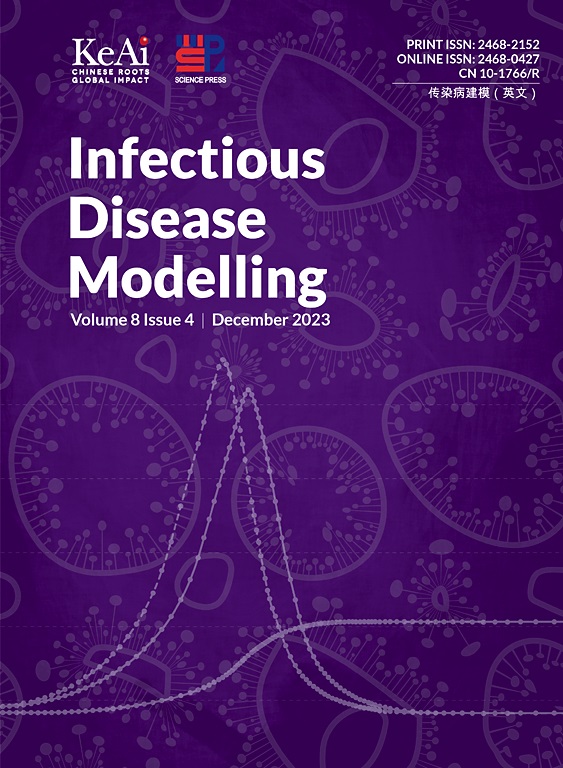Quantifying mpox transmission and control: A regional analysis of vaccination strategies in East Africa
IF 2.5
3区 医学
Q1 Medicine
引用次数: 0
Abstract
Africa is home to the endemic mpox disease, especially in the tropical rain-forest regions of Central and West Africa. Although it is mostly found in the Democratic Republic of the Congo, reports of it have also come from other neighboring African nations. To understand the dynamics of mpox, we studied its spread in Burundi, Uganda, Rwanda, Congo, and Kenya before and after the implementation of interventions. Using a Bayesian framework, a simple mathematical model of Susceptible-Infected-Recovered type was calibrated and fitted to the 2022 mpox data covering the period before the introduction of intervention strategies. The model was then re-stratified to incorporate key epidemiological features, including vaccination with imperfect efficacy, partial immunity, exposure, and demographics. The transmission of mpox varied throughout East Africa, with Uganda exhibiting the highest basic reproduction number = 2.51, suggesting the possibility of a rapid spread. Despite having the highest initial infection count and the lowest (1.23), Congo may have had delayed detection. The moderate values (1.35 and 1.88) in Rwanda and Burundi have implications for prompt intervention to control epidemics. Transmission and vaccination rates have a non-linear relationship with the thresholds required to contain mpox outbreaks. Our model shows that in high-transmission settings, substantially higher vaccination coverage (exceeding 80 % at an effectiveness of 70 %) is required to reduce the control reproduction number below unity, whereas in moderate-transmission contexts, coverage above 40 % may suffice. These quantitative thresholds provide actionable guidance for tailoring vaccination strategies to different epidemiological conditions. In particular, sustained vaccination strategies that achieve coverage above the threshold predicted by our model (approximately 80 %) can guarantee mpox eradication, even in situations with strong transmission rates. While real-world complexities such as heterogeneous risk groups and behavioral factors may affect outcomes, these findings shed light on potential quantitative thresholds and provide a foundation for more detailed, population-specific modeling of mpox interventions.
量化m痘传播和控制:东非疫苗接种战略的区域分析
非洲是流行性痘病的发源地,特别是在中非和西非的热带雨林地区。虽然它主要在刚果民主共和国被发现,但也有来自其他邻近非洲国家的报道。为了了解麻疹的动态,我们研究了实施干预措施前后在布隆迪、乌干达、卢旺达、刚果和肯尼亚的传播情况。使用贝叶斯框架,校准了易感-感染-恢复类型的简单数学模型,并将其拟合到2022年mpox数据中,该数据涵盖了引入干预策略之前的时期。然后对模型进行重新分层,以纳入关键的流行病学特征,包括不完全有效的疫苗接种、部分免疫、暴露和人口统计学特征。麻疹在东非各地的传播情况各不相同,乌干达的基本繁殖数R0 = 2.51最高,表明有可能迅速传播。尽管刚果有最高的初始感染计数和最低的R0(1.23),但可能延迟了检测。卢旺达和布隆迪的中等R0值(1.35和1.88)对迅速采取干预措施控制流行病具有影响。传播和疫苗接种率与控制痘暴发所需的阈值呈非线性关系。我们的模型表明,在高传播环境中,需要更高的疫苗接种覆盖率(在70%的有效性下超过80%)才能将控制繁殖数减少到1以下,而在中等传播环境中,40%以上的覆盖率可能就足够了。这些定量阈值为根据不同的流行病学情况调整疫苗接种战略提供了可操作的指导。特别是,即使在传播率很高的情况下,实现覆盖率超过我们模型预测的阈值(约80%)的持续疫苗接种战略也可以保证根除痘。虽然现实世界的复杂性,如异质性风险群体和行为因素可能会影响结果,但这些发现揭示了潜在的定量阈值,并为更详细的、针对人群的m痘干预建模提供了基础。
本文章由计算机程序翻译,如有差异,请以英文原文为准。
求助全文
约1分钟内获得全文
求助全文
来源期刊

Infectious Disease Modelling
Mathematics-Applied Mathematics
CiteScore
17.00
自引率
3.40%
发文量
73
审稿时长
17 weeks
期刊介绍:
Infectious Disease Modelling is an open access journal that undergoes peer-review. Its main objective is to facilitate research that combines mathematical modelling, retrieval and analysis of infection disease data, and public health decision support. The journal actively encourages original research that improves this interface, as well as review articles that highlight innovative methodologies relevant to data collection, informatics, and policy making in the field of public health.
 求助内容:
求助内容: 应助结果提醒方式:
应助结果提醒方式:


